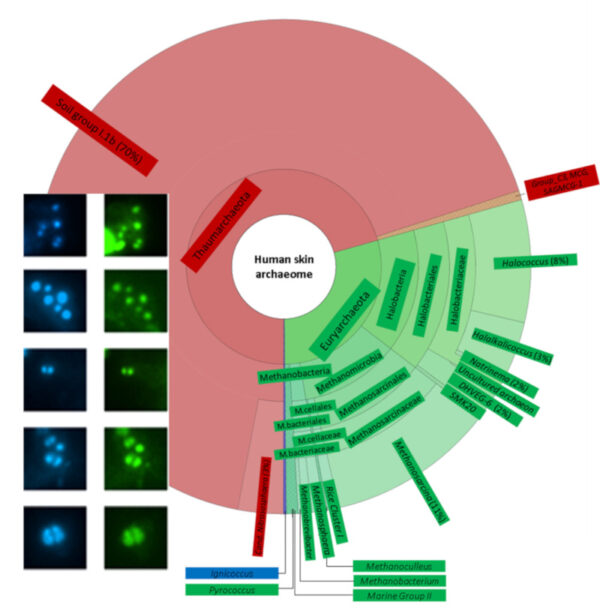Archaeal Abundance on Human Skin Changes with Age
06/22/2017

(Left, blue and green images) Fluorescence images of archaeal cells in skin wipe samples; the Advanced Light Source (ALS) at Argonne National Laboratory was used to measure infrared absorption spectra of different Archaea types. (Right, illustration) The hierarchical chart of the human skin archaeome with Thaumarchaeota (red), Euryarchaeota (green), and Crenarchaeota (blue). [From Moissl-Eichinger, C., et al. (2017). DOI:10.1038/s41598-017-04197-4. Reused under a Creative Commons license (CC BY 4.0, https://creativecommons.org/licenses/by/4.0/).]
A 2017 study discovers archaea among the billions of bacteria comprising the human skin microbiome, and that their abundance varies with a person’s age.
To characterize the microbes that live on human skin, researchers from Austria collaborated with Hoi-Ying Holman and other beamline scientists at the Berkeley Synchrotron Infrared Structural Biology Imaging Program, a BER-supported infrared beamline at the Advanced Light Source at Lawrence Berkeley National Laboratory. The research was a joint project between NASA and the European Space Agency.
Based on the chemical specificity of infrared spectroscopy, the infrared beamline rapidly and precisely characterized samples from the skin of human volunteers aged 1 to 75 years and determined the levels and types of microbes present. The analysis was then linked back to genomic data collected by the Austrian team, which revealed the presence of archaea. Before the study, the existence of archaea on human skin was unknown.
The genetic and chemical analyses of samples collected from showed that archaea were most abundant in subjects younger than 12 and older than 60, and in people with dry skin. Archaeal abundance was not associated with sex. The detected archaea are thought to be involved in nitrogen turnover and can lower skin pH, which helps suppress pathogens and prevent infection.
Instruments and Facilities
Fluorescence in situ hybridization (FISH); quantitative polymerase chain reaction (PCR); next-generation sequencing; Fourier Transform infrared (FTIR) focal plan array (FPA) hyperspectral imaging. Facilities: Advanced Light Source at the Berkeley Synchrotron Infrared Structural Biology Imaging Project; BioTechMed-Graz, the Bavaria California Technology Center.
Funding Acknowledgements
Support: BioTechMed-Graz, the Bavaria California Technology Center (BaCaTeC), and University of Regensburg. AJP support: German National Academic Foundation (Studienstiftung des deutschen Volkes). Infrared (IR) support: Berkeley Synchrotron Infrared Structural Biology (BSISB) Program, Lawrence Berkeley National Laboratory (LBNL), funded by the Office of Biological and Environmental Research (OBER), U.S. Department of Energy (DOE) Office of Science. Advanced Light Source (ALS) at LBNL support: Office of Basic Energy Sciences (OBES), Director, DOE Office of Science, through Contract DE-AC02-225 05CH11231.
Related Links
- BER Resource: Berkeley Synchrotron Infrared Structural Biology Imaging Program
- Feature Story: What’s on your skin? Archaea, that’s what.
References
Moissl-Eichinger, C., et al. “Human Age and Skin Physiology Shape Diversity and Abundance of Archaea on Skin.” Sci. Rep. 7, 4039 (2017). [DOI:10.1038/s41598-017-04197-4].
